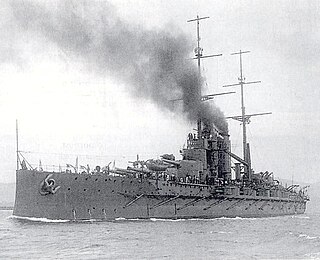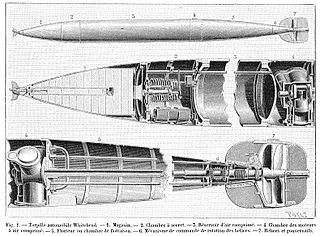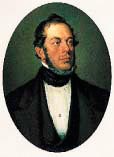
A modern torpedo is an underwater ranged weapon launched above or below the water surface, self-propelled towards a target, and with an explosive warhead designed to detonate either on contact with or in proximity to the target. Historically, such a device was called an automotive, automobile, locomotive, or fish torpedo; colloquially a fish. The term torpedo originally applied to a variety of devices, most of which would today be called mines. From about 1900, torpedo has been used strictly to designate a self-propelled underwater explosive device.

A torpedo boat is a relatively small and fast naval ship designed to carry torpedoes into battle. The first designs were steam-powered craft dedicated to ramming enemy ships with explosive spar torpedoes. Later evolutions launched variants of self-propelled Whitehead torpedoes.

Rijeka is the principal seaport and the third-largest city in Croatia. It is located in Primorje-Gorski Kotar County on Kvarner Bay, an inlet of the Adriatic Sea and in 2021 had a population of 108,622 inhabitants. Historically, because of its strategic position and its excellent deep-water port, the city was fiercely contested, especially between the Holy Roman Empire, Hungary, Italy and Croatia, changing rulers and demographics many times over centuries. According to the 2011 census data, the majority of its citizens are Croats, along with small numbers of Serbs, Bosniaks and Italians.

Janko Vuković, sometimes spelt Janko Vukovich or von Vukovich, also known as Janko Vuković de Podkapelski or Janko Vuković-Podkapelski was a Croatian naval officer who served in the Austro-Hungarian Navy and - amidst its collapse - for a brief period as commander of the fleet of the fledgling State of Slovenes, Croats and Serbs. Vuković saw action in World War I and was appointed commander of the fleet in October 1918 as the Austria-Hungary disintegrated and the entire navy was handed over to the fledgling State of Slovenes, Croats and Serbs. He died on board the SMS Viribus Unitis, sunk by Italian commandos.

Robert Whitehead was an English engineer who was most famous for developing the first effective self-propelled naval torpedo.

SMS Viribus Unitis was an Austro-Hungarian dreadnought battleship, the first of the Tegetthoff class. "Viribus Unitis", meaning "With United Forces", was the personal motto of Emperor Franz Joseph I.

Andrija Ljudevit Adamić was a Croatian trader from the City of Fiume, builder, supporter of economical and cultural development.

The Whitehead torpedo was the first self-propelled or "locomotive" torpedo ever developed. It was perfected in 1866 by Robert Whitehead from a rough design conceived by Giovanni Luppis of the Austro-Hungarian Navy in Fiume. It was driven by a three-cylinder compressed-air engine invented, designed, and made by Peter Brotherhood. Many naval services procured the Whitehead torpedo during the 1870s, including the US Navy. This early torpedo proved itself in combat during the Russo-Turkish War when, on January 16, 1878, the Ottoman ship Intibah was sunk by Russian torpedo boats carrying Whiteheads, though this story has been disputed in one book.

SM U-5 or U-V was the lead boat of the U-5 class of submarines or U-boats built for and operated by the Austro-Hungarian Navy before and during the First World War. The submarine was built as part of a plan to evaluate foreign submarine designs, and was the first of three boats of the class built by Whitehead & Co. of Fiume after a design by Irishman John Philip Holland.

SM U-23 or U-XXIII was a U-20-class submarine or U-boat built for and operated by the Austro-Hungarian Navy during the First World War. The design for U-23 was based on that of the submarines of the Royal Danish Navy's Havmanden class, and was largely obsolete by the beginning of the war.

Giovanni de Ciotta (1824–1903) was the first-born son of Lorenzo de Ciotta and Luisa de Adamich, daughter of the foremost Fiuman merchant and father of modernisation in Fiume, Andrea Lodovico de Adamich. The family de Ciotta originated from Livorno, where Giovanni served the Austrian army as an engineer. As an officer of the Austrian engineer corps, he fought in Italy in the 1848-49 campaigns and remained in the army until 1859. He arrived in Fiume in 1859 from Livorno, after having resigned from the Austrian army, reputedly for political reasons. In Fiume, initially, he lived as a landlord and commercial agent for his brother Lorenzo, who ran a trading company in Livorno, but Giovanni de Ciotta soon turned to engineering. Nevertheless, his personal life remains a mystery.
Rijeka, formerly known as Fiume, is a city located in the northern tip of the Kvarner Gulf in the northern Adriatic. It is currently the third-largest city in Croatia. It was part of the Roman province of Dalmatia, and later of the Kingdom of Croatia. It grew during the 12th to 14th centuries as a seaport within the Holy Roman Empire, trading with Italian cities. Under the rule of the House of Habsburg from 1466, it was made a free city; and, although part of the Duchy of Carniola, it developed local self-government.
The history of the Croatian Navy can be traced from the Middle Ages until modern times. See List of admirals of Croatia

Fiume was a Zara-class heavy cruiser of the Italian Regia Marina, named after the Italian city of Fiume, she was the second of four ships in the class, and was built between April 1929 and November 1931. Armed with a main battery of eight 8-inch (200 mm) guns, she was nominally within the 10,000-long-ton (10,000 t) limit imposed by the Washington Naval Treaty, though in reality she significantly exceeded this figure.
The Bloody Christmas of 1920 was a series of clashes in Fiume, which led to the conclusion of the Fiume campaign carried out by Italian poet and adventurer, Gabriele D'Annunzio in 1920.
The Schwartzkopff torpedo was a torpedo manufactured in the late 19th century by the German firm Eisengießerei und Maschinen-Fabrik von L. Schwartzkopff, later known as Berliner Maschinenbau, based on the Whitehead design. Unlike the Whitehead torpedo, which was manufactured out of steel, the Schwartzkopff was made out of bronze, enhancing corrosion resistance.

The Kaiman class were high-seas torpedo boats built for the Austro-Hungarian Navy between 1904 and 1910. A total of 24 boats were built by three shipbuilding companies. Yarrow Shipbuilders built the lead ship, Stabilimento Tecnico Triestino of Trieste built 13 boats, and Ganz-Danubius constructed the remaining 10 boats at their shipyards at Fiume. The class was considered to be a successful design, and all boats saw extensive active service during World War I, undertaking a range of tasks, including escort duties, shore bombardments, and minesweeping. All survived, although several were damaged by naval mines and collisions. One was torpedoed and badly damaged by a French submarine, and two sank an Italian submarine. All the boats were transferred to the Allies and scrapped at the end of the war, except for four that were allocated to the navy of the newly created Kingdom of Serbs, Croats and Slovenes. These were discarded and broken up between 1928 and 1930.

The Schichau class consisted of 22 torpedo boats built for the Austro-Hungarian Navy between 1885 and 1891. The class was one of the first torpedo boat classes built for the Austro-Hungarian Navy, and they were initially powered by steam from a single locomotive boiler and were armed with two 37 mm (1.5 in) Hotchkiss guns and two 356 mm (14 in) torpedo tubes. The entire class was reconstructed between 1900 and 1910, when they received two Yarrow boilers and a second funnel.
HMS Vesuvius was an experimental torpedo-armed warship of the British Royal Navy. Built by Pembroke Dockyard in 1873–1874, she was the first purpose-designed torpedo vessel built for the Royal Navy. Vesuvius was intended for night attacks against enemy harbours, and was armed with a single tube for Whitehead torpedoes in her bow. She was used for experimental and training purposes, and was not disposed of until 1923.

Agathe Gobertina von Trapp was a British-Austrian heiress and aristocrat. She was the first wife of Georg Ritter von Trapp and the mother of seven children of the Trapp Family singers.

















